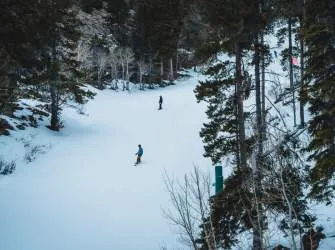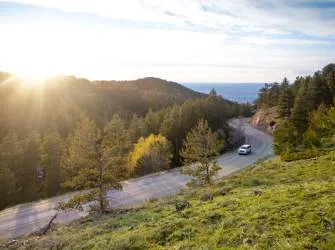Welcome to Casper, Wyoming, a destination where the landscape’s beauty is shaped by distinct and vibrant seasons. Understanding the Casper Wy Climate is essential for planning your visit, as it dictates the array of outdoor activities available throughout the year. Located in central Wyoming at an elevation of 5,150 feet above sea level, Casper experiences a semi-arid climate with four pronounced seasons, offering everything from sun-drenched summers to snowy winters.
Casper benefits from an impressive average of 220 sunny days annually, providing ample opportunity to enjoy the outdoors regardless of the time of year. While winter brings significant snowfall, averaging around 70 inches, these often coincide with clear, crisp “bluebird” days perfect for winter sports. The transitional seasons of spring and fall offer milder temperatures and unique scenic beauty.
Here’s a look at the monthly average temperatures in Fahrenheit, giving you a snapshot of the Casper Wy Climate throughout the year:
| Month | Average High (°F) | Average Low (°F) |
|---|---|---|
| January | 38 | 17 |
| February | 39 | 19 |
| March | 50 | 25 |
| April | 57 | 32 |
| May | 67 | 41 |
| June | 80 | 50 |
| July | 90 | 58 |
| August | 86 | 55 |
| September | 76 | 45 |
| October | 61 | 35 |
| November | 49 | 26 |
| December | 38 | 17 |
Please note that these are averages, and actual temperatures can fluctuate. Extreme highs and lows are possible in any season. Wind is also a notable factor in the Casper Wy Climate and throughout Wyoming, often making temperatures feel cooler, particularly in the colder months or during transitional periods.
Spring in Casper: Thawing and Awakening
Spring in Casper, generally from March through May, is a time of transition. Temperatures begin to rise, moving from average highs of 50°F in March to a pleasant 67°F by May. Lows also climb, reaching into the 40s, signaling the retreat of winter’s deep freeze. However, March and April can still see significant snowfall, often alternating with sunny periods.
This season is characterized by melting snow, blooming wildflowers, and the landscape slowly turning green. The Casper Wy Climate in spring can be unpredictable, with sudden shifts in temperature and precipitation. Layering is key when visiting during this time. Spring is excellent for early-season hiking on lower trails, fishing as ice thaws, and enjoying the less crowded atmosphere before the summer rush.
Summer in Casper: Warm Sunshine and Blue Skies
Summer, spanning June, July, and August, is arguably the most popular time to experience the Casper Wy Climate. Average high temperatures settle comfortably in the 80s and even reach the low 90s in July, accompanied by average lows in the 50s. This is the driest period of the year, offering abundant sunshine and the classic bluebird skies that Wyoming is famous for.
The warm summer weather is perfect for exploring the vast outdoor playground surrounding Casper. Activities like hiking on Casper Mountain, mountain biking, rock climbing, and water sports on the North Platte River or nearby reservoirs are in full swing. Long daylight hours allow for extended adventures. The pleasant Casper Wy Climate in summer makes it ideal for camping and other overnight outdoor excursions.
 Weather
Weather
Fall in Casper: Crisp Air and Scenic Beauty
September through November marks the autumn season in Casper. The Casper Wy Climate in fall is often characterized by crisp air, lower humidity, and stunning fall foliage as aspens and cottonwoods change color, particularly beautiful around Casper Mountain. Temperatures cool down significantly, with average highs dropping from the mid-70s in September to the high 40s by November.
Finding Your Perfect Amateur Astronomy Telescope – Expert Guide 2025
Discover the Best Michigan Places to Visit for Unforgettable Adventures in 2024
Discover the Top 11 nevada places to visit
While September can feel like an extension of summer, October and November bring colder weather and the possibility of early snowfalls. Fall is a fantastic time for hiking, fishing, and enjoying scenic drives. The cooler temperatures make strenuous activities more comfortable, and the changing colors provide a picturesque backdrop. Hunting season also begins in the fall, attracting many visitors.
Winter in Casper: A Snowy Wonderland
Winter in Casper, from December to February, transforms the area into a snowy landscape. The Casper Wy Climate during this season features average high temperatures around the high 30s and average lows in the mid to high teens. This is when Casper receives the majority of its approximately 70 inches of annual snowfall, blanketing the region and creating opportunities for winter recreation.
Despite the cold, sunny days are still frequent, allowing for enjoyable outdoor experiences. Casper Mountain is a hub for winter activities, including skiing and snowboarding at Hogadon Basin Ski Area, cross-country skiing, snowshoeing, and fat biking on groomed trails. Ice fishing is also popular on frozen lakes and reservoirs. Dressing in layers is crucial for staying warm during winter visits.
 Snowboarding at Hogadon
Snowboarding at Hogadon
High Altitude Considerations
Casper’s elevation of 5,150 feet is considerably higher than many places in the United States. Adjusting to the altitude is an important aspect of experiencing the Casper Wy Climate, regardless of the season. Thinner air at higher elevations can affect visitors, especially those coming from sea level.
Symptoms of altitude sickness can include headaches, nausea, fatigue, and shortness of breath. To mitigate these effects, it is strongly recommended to drink plenty of water, avoid excessive alcohol and strenuous activity upon arrival, and allow your body time to acclimate. Taking it easy for the first day or two can make a significant difference in your comfort and ability to enjoy your trip.
Packing Tips by Season
Knowing the Casper Wy Climate by season helps immensely with packing:
- Spring: Layers are essential. Include waterproof jackets, sweaters, long pants, and potentially warm hats/gloves alongside lighter options, as weather can change quickly.
- Summer: Pack for warm days with shorts, t-shirts, and sun protection (hat, sunscreen). However, bring a light jacket or sweater for cooler evenings, especially at higher elevations or after sundown.
- Fall: Similar to spring, layering is key. Pack sweaters, long-sleeved shirts, jeans, and a warm jacket. Be prepared for colder temperatures later in the season and potential early snow.
- Winter: Warm, insulated clothing is necessary. Pack heavy coats, waterproof pants, warm hats, gloves, scarves, and waterproof boots. Layers underneath are vital for regulating body temperature, especially when active outdoors.
Considering the wind is also advisable throughout the year; a windproof outer layer can significantly increase comfort.
Additional Weather Resources
While planning your visit based on the Casper Wy Climate, checking current conditions and forecasts closer to your travel dates is always a good idea. Websites providing local weather forecasts and road conditions (especially during winter) are invaluable tools for safe and enjoyable travel in Wyoming. Being prepared for potential weather changes will enhance your experience.
 Plan Your Trip
Plan Your Trip
Frequently Asked Questions About Casper Wy Climate
Q: What is the best time to visit Casper based on the weather?
A: This depends on your preferred activities. For warm weather outdoor adventures like hiking and water sports, summer (June-August) is ideal. For skiing and snowboarding, winter (December-February) is best. Spring and Fall offer milder temperatures and fewer crowds, great for fishing, hiking, and enjoying scenic beauty.
Q: How much snow does Casper, WY get?
A: Casper receives an average of about 70 inches of snow annually, primarily during the winter months (December-February), but early and late season snow is possible in November and March/April.
Q: Is Casper very windy?
A: Wyoming is known for its wind, and Casper is no exception. While it varies, windy conditions are common throughout the year and can make temperatures feel cooler.
Q: What should I pack for Casper in the winter?
A: Pack heavy, insulated, and waterproof layers, including a warm coat, snow pants, thermal base layers, hats, gloves, and waterproof boots. Layering is key to staying warm and comfortable.
Q: How does the altitude in Casper affect visitors?
A: At 5,150 feet, some visitors may experience mild altitude sickness symptoms like headache or fatigue. Drinking plenty of water and taking it easy upon arrival can help your body adjust.
 Casper, WY has you covered with hotels, motels, bed & breakfasts, lodges, and sites for camping and RVing. Relax in Casper after a long day of having fun.
Casper, WY has you covered with hotels, motels, bed & breakfasts, lodges, and sites for camping and RVing. Relax in Casper after a long day of having fun.
In conclusion, the Casper Wy Climate offers a diverse range of conditions throughout the year, making it a fascinating destination for all seasons. Whether you seek summer sun, autumn colors, winter snow, or spring blossoms, understanding the local weather patterns will help you plan a memorable and enjoyable trip to this unique corner of Wyoming.
